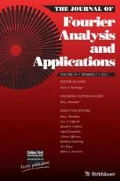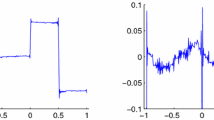Abstract
This paper considers the recovery of continuous signals in infinite dimensional spaces from the magnitude of their frequency samples. It proposes a sampling scheme which involves a combination of oversampling and modulations with complex exponentials. Sufficient conditions are given such that almost every signal with compact support can be reconstructed up to a unimodular constant using only its magnitude samples in the frequency domain. Finally it is shown that an average sampling rate of four times the Nyquist rate is enough to reconstruct almost every time-limited signal.




Similar content being viewed by others
Notes
The variable \(t\) stands here for the one or two dimensional spatial dimension.
References
Balan, R., Bodmann, B.G., Casazza, P.G., Edidin, D.: Painless reconstruction from magnitudes of frame coefficients. J. Fourier Anal. Appl. 15(4), 488–501 (2009)
Balan, R., Casazza, P.G., Edidin, D.: On signal reconstruction without phase. Appl. Comput. Harmon. Anal. 20(3), 345–356 (2006)
Bauschke, H.H., Combettes, P.L., Luke, D.R.: Phase retrieval, error reduction algorithm, and Fienup variants: a view from convex optimization. J. Opt. Soc. Am. A 19(7), 1334–1345 (2002)
Boche, H., Pohl, V.: On the calculation of the Hilbert transform from interpolated data. IEEE Trans. Inform. Theory 54(5), 2358–2366 (2008)
Bodmann, B.G., Hammen, N.: Stable phase retrieval with low-redundancy frames. Adv. Comput. Math. (2014). doi:10.1007/s10444-014-9359-y
Burge, R.E., Fiddy, M.A., Greenaway, A.H., Ross, G.: The phase problem. Proc. R. Soc. Lond. A 350(1661), 192–212 (1976)
Candès, E.J., Eldar, Y.C., Strohmer, T., Voroninski, V.: Phase retrieval via matrix completion. SIAM J. Imaging Sci. 6(1), 199–225 (2013)
Duffin, R., Schaeffer, A.C.: Some properties of functions of exponential type. Bull. Am. Math. Soc. 44, 236–240 (1938)
Falldorf, C., Agour, M., Kopylow, C.V., Bergmann, R.B.: Phase retrieval by means of spatial light modulator in the Fourier domain of an imaging system. Appl. Opt. 49(10), 1826–1830 (2010)
Fickus, M., Mixon, D.G., Nelson, A.A., Wang, Y.: Phase retrieval from very few measurements. Linear Algebr. Appl. 449, 475–499 (2014)
Fienup, J.R.: Phase retrieval algorithms: a comparison. Appl. Opt. 21(15), 2758–2769 (1982)
Fienup, J.R., Marron, J.C., Schulz, T.J., Seldin, J.H.: Hubble space telescope characterized by using phase-retrieval algorithms. Appl. Opt. 32(10), 1747–1767 (1993)
Finkelstein, J.: Pure-state informationally complete and “really” complete measurements. Phys. Rev. A 70, 052107 (2004)
Goodman, J.W.: Introduction to Fourier Optics. McGraw-Hill Comp, New York (1996)
Hayes, M.H., Lim, J.S., Oppenheim, A.V: Signal reconstruction from phase or magnitude. IEEE Trans. Acoust. Speech Signal Process. ASSP-28, 6, 672–680 (1980)
Hörmander, L.: Linear Partial Differential Operators. Springer, Berlin (1976)
Jaming, P.: The phase retrieval problem for the radar ambiguity function and vice versa. IEEE International Radar Conference, May 2010
Katkovnik, V., Astola, J.: Phase retrieval via spatial light modulators phase modulation in 4f optical setup: numerical inverse imaging with sparse regularization for phase and amplitude. J. Opt. Soc. Am A 29(1), 105–116 (2012)
Levenshtein, V.: On designs in compact metric spaces and a universal bound on their size. Discret. Math. 192, 251–271 (1998)
Levin, B.Y.: Lectures on Entire Functions. American Mathematical Society, Providence, RI (1997)
Levin, B.Y., Ostrovskii, I.V.: Small perturbations of the set of roots of sine-type functions. Izv. Akad. Nauk SSSR Ser. Mat 43(1), 87–110 (1979)
Lu, Y.M., Vetterli, M.: Sparse spectral factorization: unicity and reconstruction algorithms. Proceedings 36th International Conference on Acoustics, Speech, and Signal Processing (ICASSP), May 2011, pp. 5976–5979
Marchesini, S.: Phase retrieval and saddle-point optimization. J. Opt. Soc. Am. A 24(10), 3289–3296 (2007)
Miao, J., Ishikawa, T., Shen, Q., Earnest, T.: Extending X-ray crystallography to allow the imaging of noncrystalline materials, cells, and single protein complexes. Annu. Rev. Phys. Chem. 59, 387–410 (2008)
Millane, R.P.: Phase retrieval in crystallography and optics. J. Opt. Soc. Am. A 7(3), 394–411 (1990)
Mönich, U.J., Boche, H.: Non-equidistant sampling for bounded bandlimited signals. Signal Process. 90(7), 2212–2218 (2010)
Ortega-Cerdà, J., Seip, K.: Multipliers for entire functions and an interpolation problem of Beurling. J. Funct. Anal. 162(2), 400–415 (1999)
Pohl, V., Yang, F., Boche, H.: Phase retrieval from low-rate samples. Sampl. Theory Signal Image Process. (2014). arXiv:1311.7045
Pohl, V., Yapar, C., Boche, H., Yang, F.: A phase retrieval method for signals in modulation-invariant spaces. Proceedings of 39th International Conference on Acoustics, Speech, and Signal Processing (ICASSP), May 2014
Rabiner, L., Juang, B.-H.: Fundamentals of Speech Recognition. Prentice Hall Inc, Englewood Cliffs (1993)
Ross, G., Fiddy, M.A., Nieto-Vesperinas, M., Wheeler, M.W.L.: The phase problem in scattering phenomena: the zeros of entire functions and their significance. Proc. R. Soc. Lond. A 360(1700), 25–45 (1978)
Rudin, W.: Functional Analysis, 2nd edn. McGraw-Hill, Boston (1991)
Thakur, G.: Reconstruction of bandlimited functions from unsigned samples. J. Fourier Anal. Appl. 17(4), 720–732 (2011)
Vladimirov, V.S.: Equations of Mathematical Physics. Marcel Dekker Inc, New York (1971)
Xiao, X., Shen, Q.: Wave propagation and phase retrieval in Fresnel diffraction by a distorted-object approach. Phys. Rev. B 72, 033103 (2005)
Yang, F., Pohl, V., Boche, H.: Phase retrieval via structured modulations in Paley–Wiener spaces. Proceedings of 10th International Conference on Sampling Theory and Applications (SampTA), July 2013.
Young, R.M.: An Introduction to Nonharmonic Fourier Series. Academic Press, Cambridge (2001)
Zauner, G.: Quantum designs: foundations of a noncommutative design theory. Int. J. Quantum Inform. 9(1), 445–507 (2011)
Zhang, F., Pedrini, G., Osten, W.: Phase retrieval of arbitrary complex-valued fields through aperture-plane modulation. Phys. Rev. A 75, 043805 (2007)
Acknowledgments
This work was partly supported by the German Research Foundation (DFG) under Grant PO 1347/2-1 and BO 1734/22-1.
Author information
Authors and Affiliations
Corresponding author
Additional information
Communicated by Thomas Strohmer.
Appendix: An Auxiliary Lemma
Appendix: An Auxiliary Lemma
Lemma 7.1
Let \(S\) be a sine-type function of type \(\sigma \) and let \(\Lambda = \{\lambda _n\}_{n\in \mathbb {Z} }\) be its zero set. If \(\lambda _{n_{0}} \in \Lambda \) is an arbitrary zero of \(S\) then
with a constant \(C\) which depends only on \(S\) but not on \(n_{0}\).
Proof
Since \(S\) is a sine-type function there are constants \(A,B,H\) such that inequalities (6) hold. Furthermore there exists a constant \(\delta > 0\) such that \(|\lambda _{m} - \lambda _{n}| \ge \delta \) for all \(m\ne n\) and a constant \(\alpha >0\) such that \(|S'(\lambda _{n})| \ge \alpha \) for all \(\lambda _{n} \in \Lambda \) (see, e.g., [20, 37]). In particular, \(S\) is an entire function of exponential type \(\sigma \). Then the Phragmén–Lindelöf principle and (6) imply that \(S\) is bounded on every line parallel to \( \mathbb {R} \). Therefore there exists a constant \(M\) such that
Set \(\widetilde{S}(z) := S(z + \lambda _{n_{0}})\) and write \(\lambda _{n_{0}} = \xi _{0} + \mathrm {i} \eta _{0}\). It follows from (6) that \(|\eta _{0}| \le H\) and (32) gives
Consequently \(|\widetilde{S}(z)| \le \widetilde{M}\, \mathrm {e} ^{\sigma |z|}\) for all \(z\in \mathbb {C} \) and with the constant \(\widetilde{M} = M \mathrm {e} ^{\sigma H}\) which depends only on \(S\) but not on \(n_{0}\). The zeros of \(\widetilde{S}\) are \(\widetilde{\lambda }_{n} = \lambda _{n} - \lambda _{n_0}\), and we assume that they are ordered increasingly by their absolute values, i.e. such that \(0 = |\widetilde{\lambda }_{0}| < \delta \le |\widetilde{\lambda }_1| \le |\widetilde{\lambda }_{2}| \le \cdots \). Then we define \(Q(z) := \widetilde{S}(z)/z\). This is again an entire function of exponential type \(\sigma \) which satisfies
and the zero set of \(Q\) is obviously \(\{\widetilde{\lambda }_n\}^{\infty }_{n=1}\). If \(n(r)\) denotes the number of zeros of \(Q\) for which \(|\widetilde{\lambda }_n| \le r\), then Jensen’s formula [20] and (33) imply
Since \(n(r)\) is non-decreasing, we have \(N(e r) \ge \int ^{e r}_{r} n(\tau )\, \tau ^{-1}\, \mathrm {d} \tau \ge n(r)\), where \(e = \mathrm {e} ^{1}\). This yields the upper bound \(n(r) \le \ln (P/\alpha ) + e\, \sigma \, r\). If we take \(r = |\widetilde{\lambda }_{n}|\) then \(n(r) = n\) and one gets \(n = n(r) \le \ln (P/\alpha ) + e\, \sigma \, |\widetilde{\lambda }_n|\). Now we have
where \(N \in \mathbb {N} \) was chosen as the smallest integer such that \(N \ge \ln (P/\alpha ) + 1\). Next we use for the first sum on the right hand side that \(|\widetilde{\lambda }_{n}| \ge \delta \) for all \(n \ge 1\). In the second sum we apply the bound \(|\widetilde{\lambda }_{n}| \ge [ n-\ln (P/\alpha ) ]/[e\, \sigma ]\) from above. This gives
where the constant \(C<\infty \) is independent of \(n_0\) and depends only on \(S\). \(\square \)
Rights and permissions
About this article
Cite this article
Pohl, V., Yang, F. & Boche, H. Phaseless Signal Recovery in Infinite Dimensional Spaces Using Structured Modulations. J Fourier Anal Appl 20, 1212–1233 (2014). https://doi.org/10.1007/s00041-014-9352-3
Received:
Revised:
Published:
Issue Date:
DOI: https://doi.org/10.1007/s00041-014-9352-3




